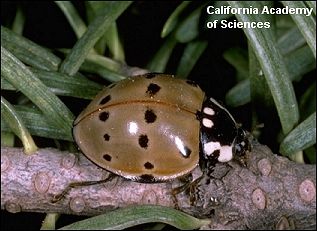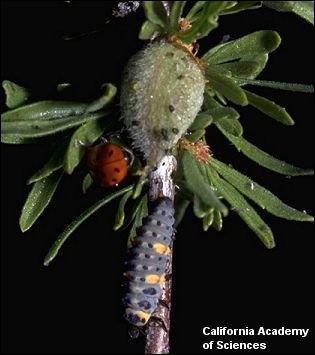
"Watcha gonna do—bleed on me??!" Many of us remember this famous line from Monty Python's "Search for the Holy Grail", but if you were talking to a ladybug, this might be an appropriate question. A ladybug under attack defends itself with "reflex bleeding"—where it oozes blood from the joints in its legs. In some, this blood contains coccinelline, an unpleasant substance that encourages most birds and ants to leave it alone!
Despite the name, "ladybugs" aren't all female—and they're not even true bugs. A more appropriate name for them is "ladybird beetles"—at least a name like that makes it clear that they are beetles! You may think you'd recognize a ladybug anywhere, but many of them look surprisingly unlike the common red spotted type. Some are totally black, and others have stripes instead of spots.
Larval ladybugs may look like ugly pests attacking your plants, but if
you learn to recognize them, you'll realized these young beetles actually protect
your plants, just as the adults do. Both eat destructive insects, such as aphids.

Listen to the Audio (mp3 format) as recorded by KTEP, Public Radio for the Southwest.
Contributor: Kodi R. Jeffery, Centennial Museum, University of Texas at El Paso.
Desert Diary is a joint production of the Centennial Museum and KTEP National Public Radio at the University of Texas at El Paso.

Ladybug adult. Photograph by T. W. Davies; © 1999, California Academy of Sciences.

Ladybug adult and larva. Photograph by Gerald and Buff Corsi; © 1999, California Academy of Sciences.
Teacher's Guide by Patricia L. Lucas.